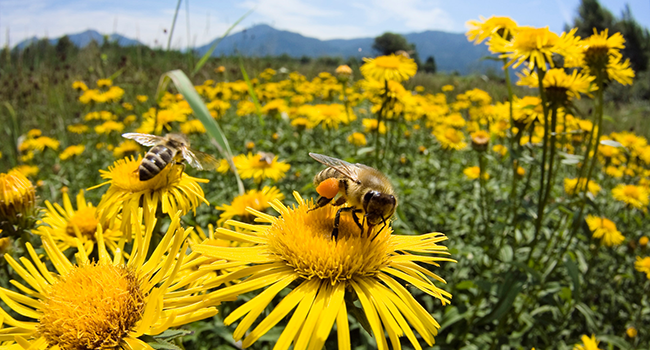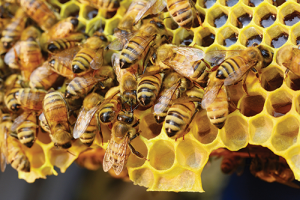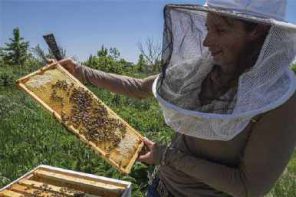By Greta Burroughs
Watching, Listening & Learning – Citizen Science Comes To The Honey Bee.
It is getting more and more complicated to be a successful beekeeper. Outsiders think all you have to do is set up a few hives, get the bees and let them do all the work.
At one time, our father or grandfather may have operated that way. But today the bees are more susceptible to outside factors affecting their health and production, leaving you, their guardian, with the responsibility of finding the solutions to their problems.
James Wilkes discovered this fact when he established a few colonies of bees in 2000. “My dad had bees while I was growing up. He got his first bees in 1964. At that time, the most important thing was to give them space. They did their thing, and we did ours.
“The biggest issue back then was to add boxes to the hive in Spring when they started growing, and then harvest the honey at the end of Summer. Today, there are a lot of pressures on bee health that makes the old way of doing it unsuccessful. We have to manage the bees or they’ll die.”
Rich Morris noticed many of his bees died during the winter. “We closed up the hives in November and opened them back up in March to see if the bees were dead or alive. It was frustrating to see so many dead bees. I wanted to know when, why and how they died and figure out interventions to keep it from happening any more.”
Both gentlemen wanted to know if other beekeepers had the same or similar problems and provide a solution. Wilkes and Morris needed to contact, communicate with and brainstorm with fellow beekeepers. They both found the means to do just that through citizen science.
“Beekeepers are naturally citizen scientists. They do a lot of experimenting, asking questions and learning through trial and error. It’s inherent in the beekeeping culture to ask why and then find ways to make it better.”
What is Citizen Science?
Citizen scientists voluntarily contribute their time, effort and resources toward scientific research. Most beekeepers do not consider themselves as scientists but in actuality you are. You see a problem that needs to be addressed and use trial and error or experimental methods to solve the problem. That is the basic principle of scientific research.
Maintaining your own hives is as important as the research conducted in formal clinical studies. It is a hands-on approach that searches for the best answer. The same issues and problems inevitably arise throughout the honey bee industry, and the solutions you discover may benefit other beekeepers. By participating in citizen science projects, those results can be shared.
The value of citizen science comes in when a group of people work on one particular issue and share the information, otherwise known as crowdsourcing. There are a number of ongoing beekeeping related citizen science projects listed on xerces.org, SciStarter.com and iNaturalist.org. These and other web-based platforms support and encourage ordinary people to join in and contribute to scientific research.
Candace Fallon, Monarch Projects Coordinator for xerces.org says, “Having a crowdsourced project is incredible because you can have a lot of people on the ground gathering data, way more than a single researcher or team can collect.”
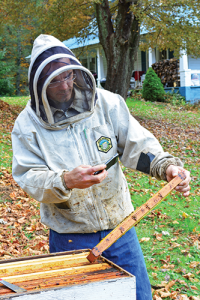
Modern technology is wonderful. James Wilkes keeps track of the data gathered during his hive inspections with an app he developed called Hivetracks. (courtesy of James Wilkes)
Citizen Science in Action
A benefit of citizen science is the ability to help others. Wilkes was interested in maintaining a healthy hive so he developed a way to collect and save valuable information from inside the hives.
Wilkes’ focus was to perfect a method of obtaining and storing data gathered during hive inspections to notate any changes. He created a tool called Hivetracks where beekeepers can maintain a record of the information and use it to improve the health and productivity of the honey bees.
He explains, “It’s sort of like a web-based logbook of inspections so beekeepers can keep track of their own hives as well as [have the information available to] do citizen science. They can contribute data and information to the beekeeping community to better understand honey bee health, practices, and answer any questions someone may have.”
Morris began his citizen science project by engaging other people to document what is normal for beehives across the nation. He summarizes his idea, “I wanted to create a device for beekeepers that would automatically record the conditions inside the hive 24/7. It would have a simple way to harvest the information by cell phone and be able to send it effortlessly to a nationwide database. There’s been a lot of work done previously but mostly only on a local level. My aim is to get lots of data in order to see trends and make the information public domain so everyone can have access to it.”
Morris’ device, called Broodminder, records temperature, humidity and weight in the hive, as well as indicating the presence of brood which is very important for the growth of the hive.
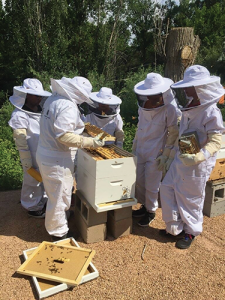
Jane Crayton works with young people through a 4-H Youth Development Program in Pueblo County, CO. She also runs the BeeWise Beekeeping Camp during the Summer months where she shares her passion for honey bees with the kids. In this picture, Crayton is showing the youth a frame of emerging brood. (courtesy of Jane Crayton)
Jane Crayton works with kids through a 4-H Youth Development Program and wanted to share her passion for honey bees with the kids. She developed the BeeWise Honey Bee Pollen & Nectar Map to engage the young people in gathering data and learning about the kinds and locations of plants bees prefer as well as the time of year bees collect pollen from them.
She says, “This started as a way to teach students how to do citizen science and to be friends with bees. Since then, the scientific aspect has grown and BeeWise has become a tool for all beekeepers to use to chart the data of what’s blooming and when nectar flows, locations, etc.”
These three citizen science projects were created to provide great web-based tools for beekeepers to use in maintaining the health and productivity of their hives. Other projects ask for your assistance in gathering information.
Bees and EZ Water request pictures and information on how, when and where bees water and if any particular types of water affect honey production.
ZomBee Watch is mapping locations across North America where honey bees have been infected by the zombie fly.
Feral Honeybee Colonies is asking for help in locating, describing, and measuring feral honey bee colonies.
By participating in projects like these, you can help the bee whisperers to better understand what the honey bees are trying to tell us. Along the way, you watch, listen and learn from the pollinators. You may even come up with your own observations not covered in any of the existing forums; something you would like to follow up on. Would it be worth the time and effort to start your own project?
Beekeeping Citizen Science Projects
Hivetracks.com – https://hivetracks.com/index.php
Broodminder.com – https://broodminder.com/
ZomBee Watch – https://www.zombeewatch.org/
BeeWise Honey Bee Pollen and Nectar Map – https://www.inaturalist.org/projects/beewise-honey-bee-pollen-nectar-map
Bees and EZ Water – https://scistarter.com/project/17710-Bees-and-EZ-Water
Feral Honeybee Colonies – https://scistarter.com/project/20291-Feral-honeybee-colonies
Platforms to Create Your Own Citizen Science Project
CitSci.org – http://citsci.org/
CrowdCrafting – https://crowdcrafting.org/
Zooniverse – https://www.zooniverse.org/lab
iNaturalist – https://www.inaturalist.org/
Setting up a Citizen Science Project
“Beekeepers are naturally citizen scientists,” observes Wilkes. “They do a lot of experimenting, asking questions and learning through trial and error. It’s inherent in the beekeeping culture to ask why and then find ways to make it better.”
If you notice an issue and want feedback from others to resolve it, should you begin a project to get the help you need?
Darlene Cavalier, a professor at Arizona State University and the founder of SciStarter.com advises careful consideration before tackling the task of starting a citizen science project.
“It’s a lot of work; a big responsibility to follow through to the end,” says Cavalier. “You have to devote a lot of time and effort and be available for comments and questions from volunteers. You have to sift through the data and post updates and do whatever it takes to keep the interest of the participants.”
She suggests, “If it is a general question, post it on a beekeeper website or on an existing citizen science project, or use social media platforms such as Twitter.
“If you need evidence-based information to resolve the problem or answer a question, then definitely do a project to get data, maps, photos, etc.”
The general consensus of everyone asked about how to set up a new project echoes Jane Crayton’s thoughts, “First of all, participate in one or more citizen science projects to get the feel of what others are doing and how it is being done. Make sure you have the time to devote to it.”
Other suggestions from the experienced citizen scientists include:
- Determine the information you want. Make it simple and easy to gather, not requiring a lot of time or difficulty on the part of the participants.
- Write up a description that includes the data needed, time frame, location, and the tools and information needed from participants (photos, records of date, time, location, etc.)
- Design a project page using a template from one of the citizen science platforms (iNaturalist, CitSci.org, CrowdCrafting, Zooniverse)
- Monitor your project daily replying to all questions and comments from the volunteers. Thank people for their help.
- Keep track of the data and post updates on a regular basis.
- Devote lots of time to the project and keep it interesting.
A popular platform for setting up citizen science projects is iNaturalist.com. Tony Iwane, Outreach and Community Coordinator for the website comments, “Many people join iNaturalist and immediately start a project, but it’s difficult to do that without experience with our platform and community, and without a very strong commitment to continue engagement and outreach. So we recommend that you start out as a participant, make some observations, add some identifications to other users’ observations, and enjoy yourself out in nature.”
To sum it up, think twice before starting a project. Make sure you have the time and dedication it takes to follow through. But by all means, if you believe it will benefit the beekeeping community, go for it.
Citizen Science is Contagious
Whether you are a volunteer or an administrator, you will find yourself drawn to participate in citizen science more and more. It may start out as a beekeeping related project but lead to other subjects such as Alzheimer’s research, weather, or the environment.
Cavalier sums up the reasons why we participate in citizen science. “We do it to connect socially, as a way to make the world a better place, to give back, because it’s good for soul, mind and body, and most of all for the pure joy of it.”
She also points out that it is satisfying to know you can do things to advance research and knowledge without a formal degree and without taking a whole lot of time.
Whatever your reason for becoming a citizen scientist, the honey bees thank you.
Sources
Jane Crayton
BeeWise Honey Bee Pollen & Nectar Map (project)
STEAM / 4-H Youth Development
Colorado State University Extension, Pueblo County
719-557-1633
Candace Fallon
Monarch Projects Coordinator
954-815-5429
Darlene Cavalier
Arizona State University
Professor of Practice
Center for Engagement and Training in Science and Society
School for the Future of Innovation in Society
Founder of SciStarter
(267) 253-1310
James Wilkes
828-265-6263
https://hivetracks.com/index.php
Rich Morris
608.201.6227
Tony Iwane
Outreach and Community Coordinator
iNaturalist
iNaturalist – how to set up project https://www.inaturalist.org/pages/managing-projects
SciStarter – about Citizen Science – https://scistarter.com/citizenscience.html
Greta Burroughs has worked as a freelance writer since 2005 and has been published in magazines and newspapers as well as online publications. She enjoys discovering, researching and writing about interesting topics people may not be familiar with. Whether it be health-related, historical, human interest, or nature/environmental issues, there are many stories out there begging for attention, and Greta is on the lookout for them. You can usually find her typing madly away at her home in South Carolina where she resides with her husband and three dogs.







